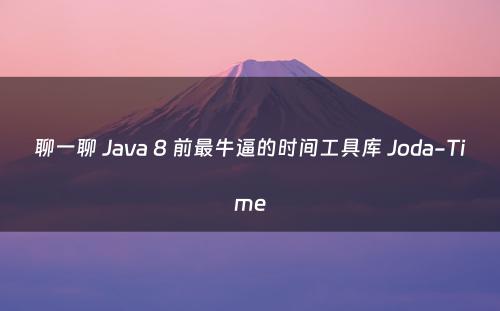网站首页 > java教程 正文
一、简介
Joda-Time 是 Java 8 发布之前使用最广泛的日期和时间处理库。其目的是提供一个直观的 API 来处理日期和时间,并解决 Java Date/Time API 中存在的设计问题。
随着 Java 8 版本的发布,JDK 核心中引入了该库中实现的中心概念。新的日期和时间 API 可以在java.time包 ( JSR-310 )中找到。

Java 8 发布后,我认为该项目已基本完成,并建议如果可以的话使用 Java 8 API。
2. 为什么使用Joda-Time?
Java 8 之前的日期/时间 API 存在多个设计问题。
问题之一是 Date 和SimpleDateFormatter 类不是线程安全的。为了解决这个问题,Joda-Time 使用不可变类来处理日期和时间。
Date类并不表示实际的日期,而是指定一个时间点,具有毫秒精度。Date中的年份从1900年开始,而大多数日期操作通常使用从1970年1月1日开始的纪元时间。
此外,Date中的日子、月份和年份偏移是反直觉的。日子从0开始,而月份从1开始。要访问其中的任何一个,我们必须使用Calendar类。Joda-Time提供了一个干净且流畅的API来处理日期和时间。
Joda-Time还支持八种日历系统,而Java只支持两种:公历(java.util.GregorianCalendar)和日本日历(java.util.JapaneseImperialCalendar)。
3. 引入 joda-time 依赖
<dependency>
<groupId>joda-time</groupId>
<artifactId>joda-time</artifactId>
<version>2.10</version>
</dependency>4. 库概述
Joda-Time使用org.joda.time包中的类 对日期和时间的概念进行建模。
最常用的类如下:
- LocalDate – 表示没有时间的日期
- LocalTime – 表示不带时区的时间
- LocalDateTime – 表示不带时区的日期和时间
- Instant – 表示从 Java 纪元 1970-01-01T00:00:00Z 开始的精确时间点(以毫秒为单位)
- Duration – 表示两个时间点之间的持续时间(以毫秒为单位)
- Period – 与Duration类似,但允许访问日期和时间对象的各个组成部分,例如年、月、日等。
- Interval – 表示2个瞬时之间的时间间隔
其他重要的特性是日期解析器和格式化程序。这些可以在org.joda.time.format包中找到。
日历系统和时区特定的类可以在org.joda.time.chrono和org.joda.time.tz包中找到。
接下来看一些示例。
5. 表示日期和时间
5.1.当前日期和时间
可以使用 LocalDate 类中的 now() 方法获取 没有时间信息的当前日期:
LocalDate currentDate = LocalDate.now();当我们只需要当前时间,不需要日期信息时,可以使用 LocalTime类:
LocalTime currentTime = LocalTime.now();要获取当前日期和时间而不考虑时区,可以使用LocalDateTime:
LocalDateTime currentDateAndTime = LocalDateTime.now();可以使用toDateTime()方法获取一个DateTime对象(考虑了时区) 。当不需要时间时,我们可以使用toLocalDate()方法将其转换为LocalDate,当只需要时间时,可以使用toLocalTime()来获取LocalTime对象:
DateTime dateTime = currentDateAndTime.toDateTime();
LocalDate localDate = currentDateAndTime.toLocalDate();
LocalTime localTime = currentDateAndTime.toLocalTime();上述所有方法都有一个重载方法,接收DateTimeZone对象来指定时区:
LocalDate currentDate = LocalDate.now(DateTimeZone.forID("Asia/ShangHai"));Joda-Time 还提供了与 Java 日期和时间 API 的集成。构造函数接受java.util.Date对象,并且可以使用 toDate()方法返回java.util.Date对象。
LocalDateTime currentDateTimeFromJavaDate = new LocalDateTime(new Date());
Date currentJavaDate = currentDateTimeFromJavaDate.toDate();5.2.自定义日期和时间
Joda-Time 提供了几个构造函数来自定义日期和时间。可以指定以下对象:
- Instant 对象
- Java Date对象
- 使用 ISO 格式的日期和时间的字符串表示形式
- 日期和时间的一部分,如年、月、日、时、分、秒、毫秒
Date oneMinuteAgoDate = new Date(System.currentTimeMillis() - (60 * 1000));
Instant oneMinutesAgoInstant = new Instant(oneMinuteAgoDate);
DateTime customDateTimeFromInstant = new DateTime(oneMinutesAgoInstant);
DateTime customDateTimeFromJavaDate = new DateTime(oneMinuteAgoDate);
DateTime customDateTimeFromString = new DateTime("2018-05-05T10:11:12.123");
DateTime customDateTimeFromParts = new DateTime(2018, 5, 5, 10, 11, 12, 123);
自定义日期和时间的另一种方法是解析ISO 格式的日期和时间:
DateTime parsedDateTime = DateTime.parse("2018-05-05T10:11:12.123");还可以通过自定义DateTimeFormatter来解析日期和时间:
DateTimeFormatter dateTimeFormatter
= DateTimeFormat.forPattern("MM/dd/yyyy HH:mm:ss");
DateTime parsedDateTimeUsingFormatter
= DateTime.parse("05/05/2018 10:11:12", dateTimeFormatter);6. 使用日期和时间
6.1.使用 Instant 类
Instant 表示从 1970-01-01T00:00:00Z 到给定时刻的毫秒数。例如,可以使用默认构造函数或now()方法获取当前时刻:
Instant instant = new Instant();
Instant.now();要创建一个自定义时刻的Instant,我们可以使用Instant类的构造函数,或者使用EpochMilli()和EpochSecond()方法。
Instant instantFromEpochMilli
= Instant.ofEpochMilli(milliesFromEpochTime);
Instant instantFromEpocSeconds
= Instant.ofEpochSecond(secondsFromEpochTime);或者使用构造函数接收一个表示 ISO 格式的日期和时间的String、Java Date或表示从 1970-01-01T00:00:00Z 开始的毫秒数的long值:
Instant instantFromString
= new Instant("2018-05-05T10:11:12");
Instant instantFromDate
= new Instant(oneMinuteAgoDate);
Instant instantFromTimestamp
= new Instant(System.currentTimeMillis() - (60 * 1000));当日期和时间表示是字符串时,可以选择使用所需的格式来解析字符串:
Instant parsedInstant
= Instant.parse("05/05/2018 10:11:12", dateTimeFormatter);接下来对 Instant 进行使用。
Instant对象比较:
assertTrue(instantNow.compareTo(oneMinuteAgoInstant) > 0);
assertTrue(instantNow.isAfter(oneMinuteAgoInstant));
assertTrue(oneMinuteAgoInstant.isBefore(instantNow));
assertTrue(oneMinuteAgoInstant.isBeforeNow());
assertFalse(oneMinuteAgoInstant.isEqual(instantNow));另一个很有用的功能是 Instant 可以转换为DateTime对象或 Java Date:
DateTime dateTimeFromInstant = instant.toDateTime();
Date javaDateFromInstant = instant.toDate();当我们需要访问日期和时间的部分内容(例如年份、小时等)时,可以使用 get ()方法并指定 DateTimeField:
int year = instant.get(DateTimeFieldType.year());
int month = instant.get(DateTimeFieldType.monthOfYear());
int day = instant.get(DateTimeFieldType.dayOfMonth());
int hour = instant.get(DateTimeFieldType.hourOfDay());6.2.使用Duration、Period和Interval
Duration表示两个时间点之间的时间(以毫秒为单位),或者可以是两个Instant。
long currentTimestamp = System.currentTimeMillis();
long oneHourAgo = currentTimestamp - 24*60*1000;
Duration duration = new Duration(oneHourAgo, currentTimestamp);
Instant.now().plus(duration);还可以确定 Duration 实际是多少天、小时、分钟、秒或毫秒:
long durationInDays = duration.getStandardDays();
long durationInHours = duration.getStandardHours();
long durationInMinutes = duration.getStandardMinutes();
long durationInSeconds = duration.getStandardSeconds();
long durationInMilli = duration.getMillis();Period 和 Duration之间的主要区别 在于Period是根据其日期和时间组成部分(年、月、小时等)定义的,并不代表确切的毫秒数。使用 Period 时需要考虑时区。
例如,使用Period将1个月加到2月1日上,结果将是3月1日。由于Period库会考虑闰年,所以使用Period可以得到正确的结果。
如果我们使用Duration,结果就会不正确,因为Duration表示固定的时间量,不考虑时间顺序或时区:
Period period = new Period().withMonths(1);
LocalDateTime datePlusPeriod = localDateTime.plus(period);Interval,顾名思义,表示由两个 Instant 时间点之间的日期和时间间隔:
Interval interval = new Interval(oneMinuteAgoInstant, instantNow);这个类在我们需要检查两个区间是否有重叠,或者计算它们之间的间隔时非常有用。overlap()方法会在它们有重叠时返回重叠的区间,如果没有重叠则返回null:
Instant startInterval1 = new Instant("2018-05-05T09:00:00.000");
Instant endInterval1 = new Instant("2018-05-05T11:00:00.000");
Interval interval1 = new Interval(startInterval1, endInterval1);
Instant startInterval2 = new Instant("2018-05-05T10:00:00.000");
Instant endInterval2 = new Instant("2018-05-05T11:00:00.000");
Interval interval2 = new Interval(startInterval2, endInterval2);
Interval overlappingInterval = interval1.overlap(interval2);区间的差值可以通过gap()方法计算,而当我们想要知道一个区间的结束是否等于另一个区间的开始时,可以使用abuts()方法。
assertTrue(interval1.abuts(new Interval(
new Instant("2018-05-05T11:00:00.000"),
new Instant("2018-05-05T13:00:00.000"))));6.3.日期和时间操作
一些常见的操作是添加、减去和转换日期和时间。该库为每个类LocalDate、LocalTime、LocalDateTime和DateTime提供了特定的方法。需要注意的是,这些类是不可变的,所以每次方法调用都会创建其类型的新对象。
以LocalDateTime为例,获取当前时刻并尝试改变它的值:
LocalDateTime currentLocalDateTime = LocalDateTime.now();为 currentLocalDateTime添加一天,可以使用 plusDays()方法:
LocalDateTime nextDayDateTime = currentLocalDateTime.plusDays(1);还可以使用plus()方法向currentLocalDateTime添加Period或Duration:
Period oneMonth = new Period().withMonths(1);
LocalDateTime nextMonthDateTime = currentLocalDateTime.plus(oneMonth);这些方法对于其他日期和时间组件也是类似的,例如,plusYears()用于添加额外的年数,plusSeconds()用于添加更多的秒数等等。
如要从 currentLocalDateTime中减去一天,可以使用minusDays()方法:
LocalDateTime previousDayLocalDateTime
= currentLocalDateTime.minusDays(1);此外,除了进行日期和时间的计算,我们还可以使用withHourOfDay()方法来设置日期或时间的各个部分。例如,将小时设置为10可以通过使用withHourOfDay()方法实现。以“with”为前缀的其他方法也可以用于设置日期或时间组件:
LocalDateTime currentDateAtHour10 = currentLocalDateTime
.withHourOfDay(0)
.withMinuteOfHour(0)
.withSecondOfMinute(0)
.withMillisOfSecond(0);另一个重要的点是我们可以从日期和时间类类型转换为另一种类型。可以使用库提供的特定方法:
- toDateTime() – 将LocalDateTime转换为DateTime对象
- toLocalDate() – 将LocalDateTime转换为LocalDate对象
- toLocalTime() – 将 LocalDateTime 转换为 LocalTime 对象
- toDate() – 将LocalDateTime转换为 Java Date对象
7. 使用时区
Joda-Time 使我们可以轻松地处理不同时区并在它们之间进行更改。
Joda-Time 默认使用的时区是从用户的环境变量 `user.timezone` 中获取的。该库API允许我们为每个类或计算单独指定应该使用哪个时区。
当我们在整个应用程序中都使用特定的时区时,那么就可以设置默认的时区:
DateTimeZone.setDefault(DateTimeZone.UTC);设置完成后,所有日期和时间操作(如果没有特别指定的话)都将以UTC时区表示。
要查看所有可用的时区,可以使用getAvailableIDs()方法:
DateTimeZone.getAvailableIDs()当我们需要表示特定时区的日期或时间时,可以使用任何类LocalTime、LocalDate、LocalDateTime、DateTime并在构造函数中指定 DateTimeZone 对象:
DateTime dateTimeInChicago
= new DateTime(DateTimeZone.forID("America/Chicago"));
DateTime dateTimeInBucharest
= new DateTime(DateTimeZone.forID("Europe/Bucharest"));
LocalDateTime localDateTimeInChicago
= new LocalDateTime(DateTimeZone.forID("America/Chicago"));此外,在这些类之间进行转换时,可以指定所需的时区。
DateTime convertedDateTime
= localDateTimeInChicago.toDateTime(DateTimeZone.forID("Europe/Bucharest"));
Date convertedDate
= localDateTimeInChicago.toDate(TimeZone.getTimeZone("Europe/Bucharest"));八、结论
Joda-Time 是一个非常好用的时间工具库,在 Java 8 之前被广泛使用,Java 8 引用了它的核心概念,在实际项目中使用时,建议使用 Java 8 中的时间类库 (毕竟是官方的)。
猜你喜欢
- 2024-10-26 一些长时间GC停顿问题的排查及解决办法
- 2024-10-26 真的很实在,程序员如何精确评估开发时间?
- 2024-10-26 「JAVA面试」时间轮你了解吗?(java中的时间类)
- 2024-10-26 java判断当前日期时间大于指定日期时间 记录日常开发中的小搜索
- 2024-10-26 java如何优雅的实现时间控制(java 时间控件)
- 2024-10-26 整理 | Java日期工具类(java操作日期的类)
- 2024-10-26 Java8 新特性:新日期与时间(java 日期操作)
- 2024-10-26 java 和 go 的定时器对比(java定时器和多线程的区别)
- 2024-10-26 Java时间类Date与Calendar的区别与使用
- 2024-10-26 Mysql客户端上,时间为啥和本地差了整整13个小时,就离谱
欢迎 你 发表评论:
- 最近发表
- 标签列表
-
- java反编译工具 (77)
- java反射 (57)
- java接口 (61)
- java随机数 (63)
- java7下载 (59)
- java数据结构 (61)
- java 三目运算符 (65)
- java对象转map (63)
- Java继承 (69)
- java字符串替换 (60)
- 快速排序java (59)
- java并发编程 (58)
- java api文档 (60)
- centos安装java (57)
- java调用webservice接口 (61)
- java深拷贝 (61)
- 工厂模式java (59)
- java代理模式 (59)
- java.lang (57)
- java连接mysql数据库 (67)
- java重载 (68)
- java 循环语句 (66)
- java反序列化 (58)
- java时间函数 (60)
- java是值传递还是引用传递 (62)

本文暂时没有评论,来添加一个吧(●'◡'●)